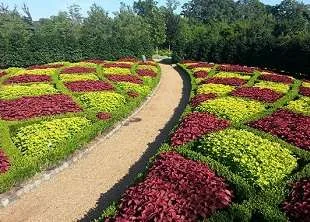This online garden design course can either fine tune the important landscaping skills you acquired upon completion of the Introduction to Garden Design course, or it can be taken as a self contained study unit. It is equally suited to those already working or looking to work in the industry, or enthusiastic gardeners with good basic landscaping knowledge. In this course you learn to design and build such things as walls, rockeries, steps, ponds, and paving; and you develop skills to create specific effects in a garden. Follow on from this course with the Garden Design III course (garden styles).
Lesson Structure
There are 12 lessons in this course:
- The Garden Environment
- The ecosystem
- Microclimates
- What do you want in a garden
- Components of a garden
- Landscaping with water
- Choosing a construction method for a water garden
- Making a pool with a liner
- Other types of water gardens
- Water garden effects
- Creating a waterfall
- Cascades
- Fencing and safety
- Plants for water gardens
- Landscape Materials
- Tools
- Tool maintenance
- Garden clothes
- Construction materials
- Concrete and cement
- How to mix concrete and mortar
- Reinforcing, rodding, expansion joints
- Gravel and mulched paths
- Outdoor furniture
- Timber: types, stains, paints, preservatives
- Plastics, Metal, Upholstery
- Furniture design
- Using Bulbs, Annuals and other Low Growing Plants
- Annuals
- Scented annuals
- Coloured foliage
- Flower bed layout
- Bedding schemes
- Selecting annuals according to height
- Annuals in containers
- Bulbs
- Scented bulbs
- Amaryllis
- Gladioli
- Narcissus
- Dahlia
- Hyacinth
- Iris
- Ranunculus
- Using Herbs
- Types of herb gardens
- Landscaping with Trees
- Introduction
- Successions
- Fast growing trees
- Choosing plants
- Trees in the landscape
- Problems with trees
- Plant applications for trees, shrubs, ground covers
- Trees with damaging roots
- Trees with narrow canopies
- Aesthetic criteria for planting design
- Procedure for planting design
- Ground Cover Plants
- Introduction
- Ground Covers: conifers, climbers, creepers, ornamental grasses
- Low grasses to grow
- How to build raised beds
- Grevilleas
- Thryptomene
- Brachysema
- Chorizema
- Hardenbergia
- Kennedya
- Herbs: Thyme, chamomile, mint, alpine strawberry, etc
- Landscaping with ferns
- Walls and Fences
- Introduction
- Getting the style right
- Different fences
- Plants to grow on trellis
- Espaliers
- Garden arches
- Choosing the rich arch
- Timber and metal arches
- Paths and Paving
- Introduction
- Where to use surfacing
- Paving: different types of materials
- Selecting materials
- Concrete
- Gravel
- Asphalt
- Edging
- Edging materials
- Maintaining an edge
- Aesthetics
- Treating Slopes and Other Problem Areas
- Erosion control
- Helping plants establish on a slope
- Drip irrigation, mulches, tree guards
- Pocket planting, slope serration, wattling, spray seeding, etc
- Shade
- Plants suited to shade
- Ferns and shade
- Windbreaks, hedges and screens
- Gardening in coastal areas
- Design and planting a firebreak
- Fire resistant plants
- Garden Features
- Colour
- Complementing colours
- Outdoor living areas: Patios, seating, garden structures, pool areas, pool surrounds
- Rockeries
- Drystone walls
- Wet walls
- Garden buildings and structures
- Siting garden buildings
- What to build
- What to do with the floor
- Planting around a garden building
- Protective structures
- Types of greenhouses
- Decorative planters
- Choosing and siting a planter
- Garden lighting
- Lighting trees, paths, ponds etc
- Letterboxes
- Designing for Low Maintenance
- Introduction
- The cost of garden maintenance
- What costs
- Expensive to maintain areas or features
- Less expensive to maintain areas
- Gardening in dry areas
- Overcoming dry soils
- Drought tolerant plants
- Hardy plants for inner city gardens
- Developing a Landscape Plan
- The site planning process
- Site analysis
- Design concept
- Master plan
- Keeping it to scale
- The importance of space
- Management of Landscape Projects
- Introduction
- Mistakes to avoid
- Earthmoving
- Importing soil
- Workplace safety
Each lesson culminates in an assignment which is submitted to the school, marked by the school’s tutors and returned to you with any relevant suggestions, comments, and if necessary, extra reading.
Course Aims:
- Determine the resources required for a landscape development, including materials and equipment.
- Determine appropriate plants for different locations within a landscape.
- Determine the appropriate design and construction for landscape features, including walls, fences, pavers and buildings.
- Determine treatments for problem areas in a landscape, including slopes and hostile environments.
- Analyse maintenance requirements for a landscape.
- Develop a landscape development plan, in accordance with a client brief, and in liaison with the client.
- Plan the management of a landscape projects.

